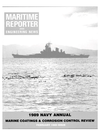
Page 16: of Maritime Reporter Magazine (February 1989)
Read this page in Pdf, Flash or Html5 edition of February 1989 Maritime Reporter Magazine
Coatings Review (continued)
ELECTROCATALYTIC
Circle 90 on Reader Service Card
Electrocatalytic, Inc., Union,
N.J., offers the Capac® impressed current protection system and the
Chloropac® system for commercial and military marine applications.
Capac impressed current protec- tion system is a leading tool selected by ship management to extend dry- dock intervals.
Capac systems employ hull po- tential control which, the company claims, is superior to conventional non-controlled sacrificial anode pro- tection. The Capac large ship anodes employ clad platinum metal on niobium and tantalum. The clad anode gives life and quality higher than either electroplated, or ther- mal type coated anodes.
The potential control of all Capac systems is guided by robust guarded, silver-silver chloride elec- trodes giving stable long life per- formance.
Used to eliminate microbiologi- cal-induced corrosion, the Chloro- pac system has been selected by over 1,000 shipowners and offshore operators to control marine fouling in seawater, firefighting, cooling and general service piping. 1989 Cummins Engine Company, Inc 18
Circle 180 on Reader Service Card
The Chloropac system is environ- mentally acceptable because it does not add any heavy metal or biocidal chemicals to the water nor does it require acid cleaning.
The Chloropac system is very ef- ficient. Water is split in the electro- chemical cell. Oxygen is added to the halogen in seawater forming hy- pobromite and hypochlorite. The halogens, especially hypobromite, are very effective biocides in ex- tremely low concentrations, typi- cally 200 parts-per-billion. Any or- ganism that attempts to attach it- self to marine metals is subject to sterilization after several days of treatment. Once the bacteria, which destroy the metal's corrosive resis- tant film, are eliminated, the low level hypobromide and hypochlo- ride enhance the metal's film form- ing.
Electrocatalytic manufactures all the components of its Capac sys- tems. Each Capac system is tailored for the individual user's require- ments. For military applications with 7 to 10 year drydock intervals, specified capacity exceeds 100mA/ m2. Commercial applications for a five-year drydock interval typically employ an 80 mA/m2 design stan- dard.
Shipboard Chloropac models are stocked in sizes from 0.01 pounds/ hour to 11 pounds/hour capable of treating all flow rates up to 70,000 gpm. The units are backed by a worldwide network of service engi- neers with spare parts in stock.
HEMPEL'S
Circle 91 on Reader Service Card
Hempel's Marine Paints has in- troduced a powerful, computer- based data storage and retrieval sys- tem, Shipdata, designed to extend the effectiveness of the firm's popu- lar "tailor-making" approach to coatings selection.
In addition, Hempel's has also introduced a range of tin-free anti- foulings for the commercial ship- ping market.
Based on data Hempel's has accu- mulated on ships coated with its products over the past decade, the
Shipdata system already contains some 25 million individual items of information (registrations) on about 13,000 ships, covering newbuildings and drydockings.
Shipdata is used for performance analysis, feedback to research and development, case histories and cus- tomized reference lists.
The registrations are used for cal- culations for a particular ship or selected number of vessels, the con- dition both before and after dry- docking, and to establish the basis for analysis of a particular coating system's performance, lifetime, etc.
Shipdata provides the informa- tion necessary for the preparation of truly tailored specifications giving, for example, reduced dry film thick- ness per coat or number of coats, or an evaluation of the safety margin or performance factor of each indi- vidual specification.
As for the coatings themselves,
Hempel's new tin-free range, which covers both non-polishing and abla- tive antifoulings, involves new tech- 18 Maritime Reporter/Engineering News

 15
15

 17
17
